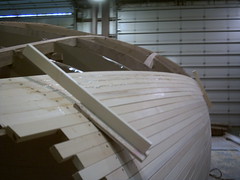Overall, putting up the veneers was a pretty neat process. But I have to admit that it got to be pretty tedious after about the 4th bag.




On a different note, I'm struggling with the aim of this blog. I think it might be too technical for most people so I am going to start toning it down quite a bit. If anyone has technical questions, leave a comment and I'll get back to you. That said, I am going to try to explain what I've been up to for the last month.
.

Veneers went on the boat at about 35 to 45 degrees of the strip-planking.

It's a little hard to see but every other plank is overlapping the plank next to it. Doing this we could cut along the edges of the planks with a razor knife to get a nice fit.

This is the technical part:
After all the planks were cut and dry fitted to the boat it was time to start getting them down there permanently. For the first layer we stapled the veneer down the old fashioned way. The reason for this was to seal the boat up for the vacuum bagging. (Trying to vacuum on top of the strip-planking would probably have caused terrible leaks because we didn't edge glue the planks together). We would take off five planks, coat them with epoxy, add thickend microspheres to the hull, and staple away. Each side required about 20,000 staples to fasten the 90 or so planks down to the hull.

Once the first layer of veneer was stapled down we were ready to start vacuum bagging them to the hull. We cut the planks as before, but now we had the challenge of getting all 90 planks on the boat and bagged before the epoxy kicked off. We ended up pre coating all the planks with epoxy, then coating the hull, and finally coating the hull again with thickend microspheres. We tacked each plank with a few staples and rushed to get the plastic bag over everything. What you are seeing in the above picture is the Dum Dum detail. The Dum Dum is the yellow stuff that sticks the plastic to the boat. A pipe goes from the vacuum into the bag and sucks the bag down to the planking. As air leaves the bag the atomsphere fills the pressure void by distributing pressure to the planking.

This is the end result, a nice, tidy vacuum bag.













